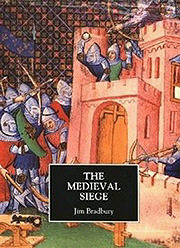
The Medieval Siege
Jim Bradbury
362 pages, with index
published in 1992
I spotted this book when I was browsing the military history shelves at the Amsterdam public library, in which subject I have some interest. It looked interesting and was on a subject I knew little about, so I checked it out.
The greater part of this book is a generalised history of siege warfare in Europe and the Mediterranean, from the fall of the western Roman Empire until the middle of the sixteenth century. the last two chapters of the book deal with the technology behind sieges, the siege engines and such as well as the conventions and laws ruling siege warfare. These last two chapters are in essence supplementary to the bulk of the book, recapping and extending on information already given piecemeal in the main text.
With the fall of the Western Roman Empire, the Roman knowledge of siege warfare did not entirely disappear from Europe and of course it was preserved in Byzantium as well. In this early period, sieges tended to concentrate on towns or cities rather than castles, which were rare. It was only around the year 1000 that castles started to appear.
With castles came castellans and counts. Owning a castle meant security, gave you control over your territory and hence was very important. So important in fact that, according to the author at least, sieges were far more important than battles in deciding wars. Castles were also increasingly cause and important factor in power struggles between the kings and their nobles. Evolution and improvement in warfare and siege techniques meant an ever increasing cost of waging war and an advantage to those kings who could control large sums of money, material and men. The nobles, especially the more powerful and independent nobles of course resisted. By the thirteenth century the advantage lay with the kings.
At the same time there were also the continuing struggles of Byzantium with first the Persians, then the Arabs and finally the Turks menancing the empire, as well as laying Constantinople itself under siege. With the start of the Crusades, these conflicts only intensified.
The crusades differed from normal Medieval wars in their ferocity and horror, since both sides fought a holy war and there was less room for following the conventions of war that lessened the horror of sieges in Europe itself. As such, the bloody slaughter when the crusaders had finally entered Jerusalem where not occasional incidents... However, something of the same sort of code of conduct did come into being after sometime, with mutal respect established.
With the coming of cannons in the late middle ages siege warfare changed again, but not as drastically as usually thought to be. At first, the cannon was just another method of destroying enemy walls, not all that different from the trebuchet or mangonel. It was used the same way and but slowly it replaced the older siege machines. Next to those, other methods of conquering an enemy town or castle stayed important, from mining to siege towers as well as starving the defenders out, if possible by destroying or diverting their water supply.
I like the way Jim Bradbury narrates and explains the above, by making use of primary sources where possible, mixing general overviews with specific examples of various sieges, not just confined to England and France, but also looking at Frederik Barbarossa's sieges in Italy, or the Spanish sieges against the Muslims there or the Northern Crusades of the Teutonic knights in Germany and Poland. He manages to give a clear, interesting account of siege warfare in the middle ages, stressing the continuity of it, but also showing the differences between early, middle and late middle ages as well as different countries and regions.
